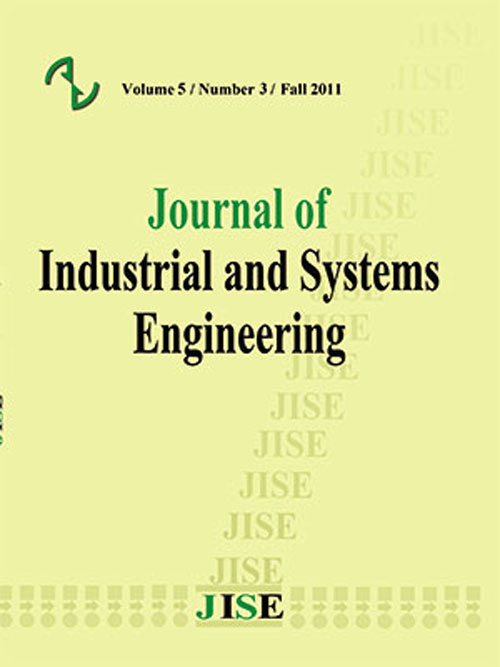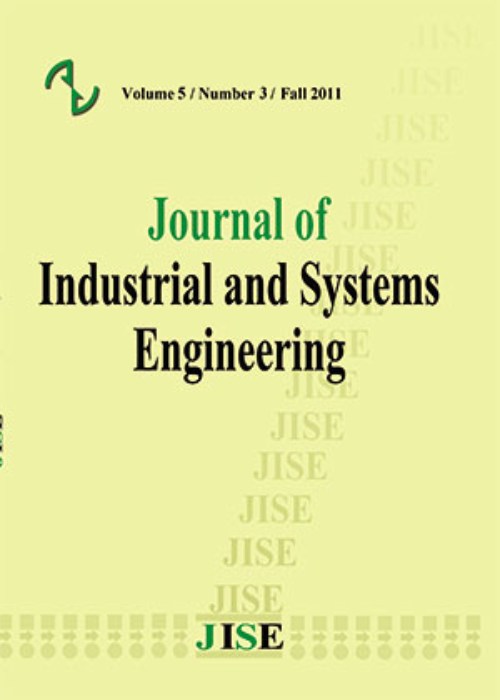فهرست مطالب

Journal of Industrial and Systems Engineering
Volume:10 Issue: 1, Winter 2017
- تاریخ انتشار: 1396/01/20
- تعداد عناوین: 9
-
-
Page 1One of the most important problems for distribution companies is to find the best locations for depots and to find proper routes for transportation vehicles and to optimize supply network. This study intends to develop a model for the problem of location-routing in post offices. So, a new Bi-Objective Location-Routing Problem for Locating Town Post Office and Routing Parcels is defined. This problem is modeled through mixed-integer mathematical programming. The aim of proposed model is to select potential post offices and to find optimal routes for transportation vehicles while time constraints are taken into account. The proposed model is applied in a real case study including eight main post area and 21 regional offices in Tehran, Iran. A goal programming approach is proposed to solve this bi-objective optimization model. The GAMS Software is used to code and solve the associated mathematical model. Some required parameters of the model such as demands are estimated using Geographical Information System (GIS) and simulation methods. The results of proposed model including the objective functions, decision variables, and proposed routing of vehicles have been compared with the existing practical solutions. Sensitivity analysis on main parameters of proposed models is accomplished and the results are analyzed. This comparison illustrate the efficacy and applicability of proposed approach.Keywords: Location-routing problem, Post Office Location-Routing, Bi-objective Optimization, Goal programming, Tehran Post Office
-
Page 18Customers and consumers are the necessities for the survival of industries and organizations. Trying to improve the process in order to increase consumer satisfaction is the most important aim. The survival of an organization depends on its ability to continue the activities in compliance with the demands of customers to meet their legitimate needs. An organization is successful when it exactly knows these needs and provides the right products. The selection of the optimal process target is an important problem in production planning and quality control. For complex manufacturing systems, process or product optimization can be instrumental in achieving a significant economic advantage. To reduce costs associated with product non-conformance or excessive waste, engineers often identify the most critical quality characteristics and then use methods to obtain their ideal parameter settings. The purpose of this study is to find the optimum targeting value. a product with two quality characteristics with independent distributions is considered. To determine the market of product sales, random sample size of lot size selected. based on the quality of products, the lot placed in primary market, secondary market, reworked and scraped. To obtain the optimum targeting value, use NSGA II algorithm with Maximize expected profit and minimize expected loss.Keywords: Quality control, Process Adjustment, Loss function, Profit
-
Page 35Reliable location routing problem considers a location problem and a vehicle routing problem in order to select the optimal location of facilities and at the same time the optimal routes for vehicles considering the unexpected failure for facilities in which, all facilities may fail with a probability. In this paper, a bi-objective mathematical model has been developed to minimize the total costs and minimize expected value of total impedance value-weighted travel distance. To approach the model to real world, two types of uncertainty in model have been considered: 1) demand-side uncertainty and 2) supply side uncertainty and also, impedance function has been utilized to operationalize the concept of accessibility in transport planning research. To solve the model, first Ɛ-constraint method has been used for multi objective solution and then we implemented a small-sized case study in an urban district in Iran. The findings offer managerial insights into how various system parameters affect the optimal solution.Keywords: Reliable location routing problem, Demand, side uncertainty, Supply, side uncertainty, Impedance function, case study
-
Page 50In this paper, we study a supply chain scheduling problem that simultaneously considers production scheduling and product delivery. jobs have to be scheduled on a single machine and delivered to customers for further processing in batches. The objective is to minimize the sum of the total weighted number of tardy jobs and the delivery costs. In this paper, we present a heuristic algorithm (HA) and a branch and bound (B&B) method for the restricted case, where the tardy jobs are delivered separately, and compare these procedures with an existing dynamic programming (DP) algorithm by computational tests. The results of computational tests show significant improvement of the B&B over the dynamic programming algorithm.Keywords: Supply chain scheduling, Batch delivery, tardy job, Branch, bound
-
Page 61The online observation of a construction site and processes bears significant advantage to all business sector. BIM is the combination of a 3D model of the project and a project-planning program which improves the project planning model by up to 6D (Adding Time, Cost and Material Information dimensions to the model). RFID technology is an appropriate information synchronization tool between the real and virtual world of BIM. Also, the use of cloud storage and computing system, would bring about outstanding data access capabilities to the constructors as well as other project participants.
The accurate prediction power that BIM brings to construction management and real-time status update, while utilizing the RFID technology, would greatly influence the efficiency of automated project management and post construction life-cycle maintenance. Meanwhile, cloud system will facilitate broad data transaction capabilities with the project. Hence, these integrations would enhance construction management by improving the data communication speed, real-time construction site control process and Human Resource Management as well. This paper introduces and evaluates a framework, which integrates Radio Frequency Identification (RFID) technology for real-time, mobile construction-site monitoring through a virtual model (BIM) and cloud data sharing as well as for processing activities. A case study has been carried out in the construction site of a new dormitory in Eastern Mediterranean University to examine different feasibilities and limitations of the framework.Keywords: BIM, Cloud Computing, RFID technology, construction management -
Page 69Nowadays, numerous processes of any supply chain are done by suppliers and consequently they cause a massive amount of pollution released to the nature. Hence, greening the suppliers has become a necessity. Although most of green supplier development programs need high investment, formal optimization models that address this issue are very rare. This paper mainly aims to address this problem by introducing a two-stage mathematical model which can help managers allocate optimal investment in their suppliers. In the first stage, suitable green supplier development programs are selected. Then, a multi-objective optimization model is presented for investing in an appropriate set of green programs, concurrently. Moreover, the conceptual framework presented in this paper provides managerial insight in every step of this process. Also, a comprehensive analysis is done under two scenarios of budget estimation and it has been found that these programs highly influence their required investment, and therefore, they must be considered, simultaneously.Keywords: Green supply chain management, green supplier development programs, non, linear multi, objective optimization model
-
Page 91This paper presents a practical algorithm for facial age estimation from frontal face image. Facial age estimation generally comprises two key steps including age image representation and age estimation. The anthropometric model used in this study includes computation of eighteen craniofacial ratios and a new accurate skin wrinkles analysis in the first step and a pairwise binary support vector machine (SVM) in the second one. Anthropometric model is the first model that has been provided; however, it hasnt been much considered and even hasnt been applied on any large database so far. Therefore, the algorithm is applied on FG-Net database and the average of the absolute errors (MAE) and cumulative score (CS) measures are provided to make comparison with other approaches much easier. Experimental results show that the proposed method can give MAE=6.34 and CS (Keywords: Data Mining, classification, Support Vector Machine, SVM, facial age estimation
-
Page 108A p-hub center network design problem is definition of some nodes as hubs and allocation of non-hub nodes to them wherein the maximum travel times between any pair of nodes is minimized. The distinctive feature of this study is proposing a new mathematical formulation for modeling costs in a p-hub center problem. Here, instead of considering costs as a linear function of distance, for the first time, we formulate costs as a summation of different parts: fixed cost, Health, Safety and Environment (HSE) cost, energy cost and personnel cost. Such integrated model results in a hard-to-solve nonlinear formulation. To validate the proposed model, a small scale problem instance of CAB dataset solved by LINGO software. Because of inability to solve bigger problems, we prepared a Genetic Algorithm (GA) by MATLAB software to solve complete problems of CAB and AP datasets.Keywords: Hub location problem, Uncapacitated single allocation p, hub center problem, Stepwise cost function, Genetic algorithm
-
Pages 125-143A set of technical, administrative and management activities are done in the life cycle of equipment, to be located in good condition and have proper and expected functioning. This is refers to be, maintenance management system (MMS). The framework and models of assessment in order to enhance effectiveness of a MMS could be proposed in two categories: qualitative and quantitative. In this research, the self-assessment’s dimensions of MMS have been established and examined that affect the successful implementation of this system in companies. This research uses a case study and review methodology (second hand material such as TPM, ISO 14224 and IEC 60300-3-14 and RAMS model) to extract dimensions, related indices and issues about how MMS to be measured and self-assessed these dimensions and indices. According to surveys and studies done by the authors the common dimensions of frameworks and models for evaluating MMS have been determined which includes; maintenance organization, training programs in maintenance, maintenance reporting, reliability engineering, maintenance – general practices, financial optimization, asset care continuous improvement, maintenance contracting, document management, the safety level of work environment, maintenance inventory and purchasing, predictive maintenance (PdM), maintenance work orders, maintenance planning and scheduling, maintenance automation(CMMS), operations/ facilities involvement on running of maintenance programs, preventive maintenance (PM) and maintenance quality management (MQM). Additionally, this paper will be presented a self-assessment framework based on the above mentioned topics for evaluation and placement of the MMS according to the total score earned in a Wireman pyramid. Then, according to the review of the literature, the appropriate indicators for each dimension of evaluation have been extracted and the framework has been tested in a petrochemical company.Keywords: maintenance management system, self-assessment framework, evaluation, total preventive maintenance (TPM), IEC 60300-3-14 standard, RAMS model


